2006 CHEVROLET EXPRESS CARGO VAN tires
[x] Cancel search: tiresPage 346 of 406
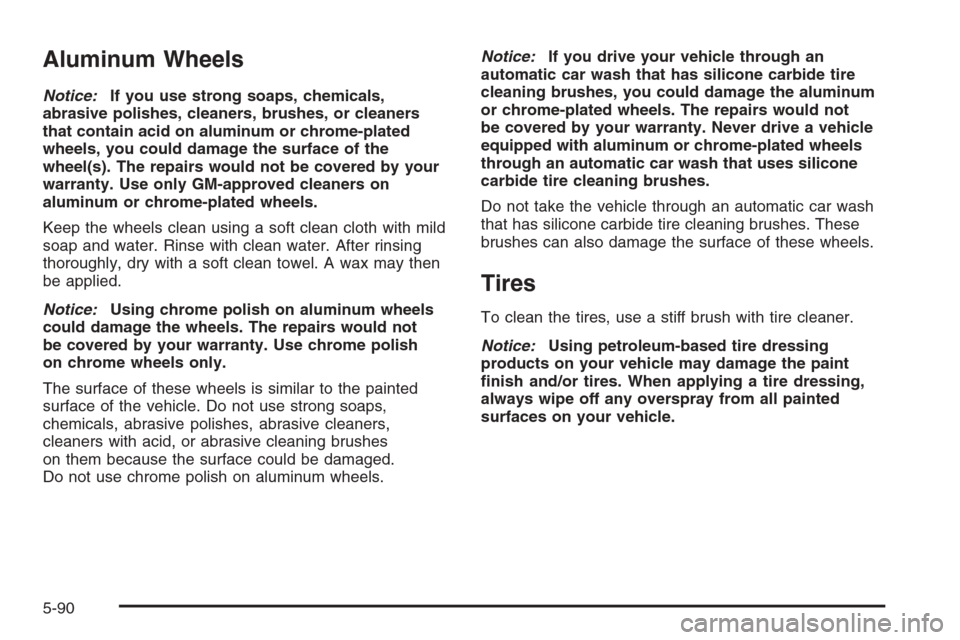
Aluminum Wheels
Notice:If you use strong soaps, chemicals,
abrasive polishes, cleaners, brushes, or cleaners
that contain acid on aluminum or chrome-plated
wheels, you could damage the surface of the
wheel(s). The repairs would not be covered by your
warranty. Use only GM-approved cleaners on
aluminum or chrome-plated wheels.
Keep the wheels clean using a soft clean cloth with mild
soap and water. Rinse with clean water. After rinsing
thoroughly, dry with a soft clean towel. A wax may then
be applied.
Notice:Using chrome polish on aluminum wheels
could damage the wheels. The repairs would not
be covered by your warranty. Use chrome polish
on chrome wheels only.
The surface of these wheels is similar to the painted
surface of the vehicle. Do not use strong soaps,
chemicals, abrasive polishes, abrasive cleaners,
cleaners with acid, or abrasive cleaning brushes
on them because the surface could be damaged.
Do not use chrome polish on aluminum wheels.Notice:If you drive your vehicle through an
automatic car wash that has silicone carbide tire
cleaning brushes, you could damage the aluminum
or chrome-plated wheels. The repairs would not
be covered by your warranty. Never drive a vehicle
equipped with aluminum or chrome-plated wheels
through an automatic car wash that uses silicone
carbide tire cleaning brushes.
Do not take the vehicle through an automatic car wash
that has silicone carbide tire cleaning brushes. These
brushes can also damage the surface of these wheels.
Tires
To clean the tires, use a stiff brush with tire cleaner.
Notice:Using petroleum-based tire dressing
products on your vehicle may damage the paint
�nish and/or tires. When applying a tire dressing,
always wipe off any overspray from all painted
surfaces on your vehicle.
5-90
Page 361 of 406
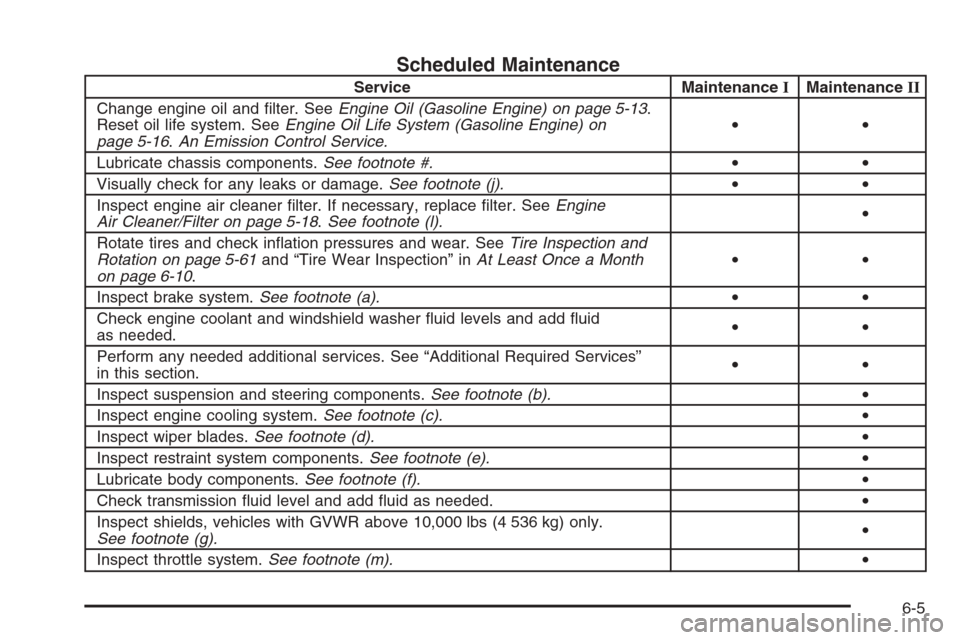
Scheduled Maintenance
Service MaintenanceIMaintenanceII
Change engine oil and filter. SeeEngine Oil (Gasoline Engine) on page 5-13.
Reset oil life system. SeeEngine Oil Life System (Gasoline Engine) on
page 5-16.An Emission Control Service.••
Lubricate chassis components.See footnote #.••
Visually check for any leaks or damage.See footnote (j).••
Inspect engine air cleaner filter. If necessary, replace filter. SeeEngine
Air Cleaner/Filter on page 5-18.See footnote (l).•
Rotate tires and check inflation pressures and wear. SeeTire Inspection and
Rotation on page 5-61and “Tire Wear Inspection” inAt Least Once a Month
on page 6-10.••
Inspect brake system.See footnote (a).••
Check engine coolant and windshield washer fluid levels and add fluid
as needed.••
Perform any needed additional services. See “Additional Required Services”
in this section.••
Inspect suspension and steering components.See footnote (b).•
Inspect engine cooling system.See footnote (c).•
Inspect wiper blades.See footnote (d).•
Inspect restraint system components.See footnote (e).•
Lubricate body components.See footnote (f).•
Check transmission fluid level and add fluid as needed.•
Inspect shields, vehicles with GVWR above 10,000 lbs (4 536 kg) only.
See footnote (g).•
Inspect throttle system.See footnote (m).•
6-5
Page 366 of 406

At Each Fuel Fill
It is important to perform these underhood checks at
each fuel �ll.
Engine Oil Level Check
Check the engine oil level and add the proper oil if
necessary. SeeEngine Oil (Gasoline Engine) on
page 5-13for further details.
Notice:It is important to check your oil regularly
and keep it at the proper level. Failure to keep your
engine oil at the proper level can cause damage
to your engine not covered by your warranty.
Engine Coolant Level Check
Check the engine coolant level and add
DEX-COOL®coolant mixture if necessary.
SeeEngine Coolant on page 5-22for further details.
Windshield Washer Fluid Level Check
Check the windshield washer fluid level in the
windshield washer fluid reservoir and add the proper
fluid if necessary.
At Least Once a Month
Tire In�ation Check
Visually inspect your vehicle’s tires and make sure they
are inflated to the correct pressures. Do not forget to
check the spare tire. SeeTires on page 5-53for further
details. Check to make sure the spare tire is stored
securely. SeeChanging a Flat Tire on page 5-71.
Tire Wear Inspection
Tire rotation may be required for high mileage highway
drivers prior to the Engine Oil Life System service
notification. Check the tires for wear and, if necessary,
rotate the tires. SeeTire Inspection and Rotation on
page 5-61.
6-10
Page 393 of 406
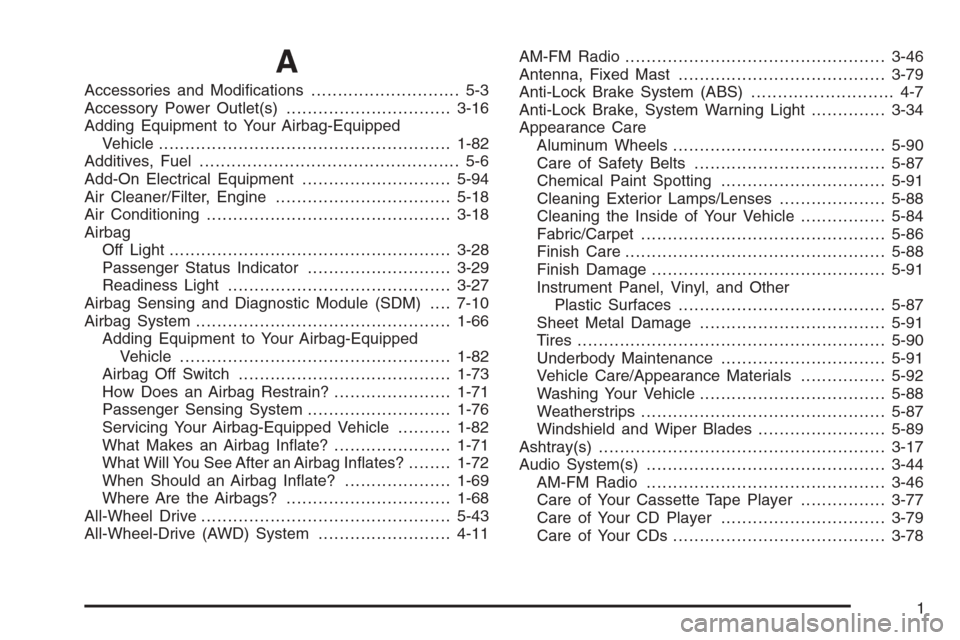
A
Accessories and Modifications............................ 5-3
Accessory Power Outlet(s)...............................3-16
Adding Equipment to Your Airbag-Equipped
Vehicle.......................................................1-82
Additives, Fuel................................................. 5-6
Add-On Electrical Equipment............................5-94
Air Cleaner/Filter, Engine.................................5-18
Air Conditioning..............................................3-18
Airbag
Off Light.....................................................3-28
Passenger Status Indicator...........................3-29
Readiness Light..........................................3-27
Airbag Sensing and Diagnostic Module (SDM)....7-10
Airbag System................................................1-66
Adding Equipment to Your Airbag-Equipped
Vehicle...................................................1-82
Airbag Off Switch........................................1-73
How Does an Airbag Restrain?......................1-71
Passenger Sensing System...........................1-76
Servicing Your Airbag-Equipped Vehicle..........1-82
What Makes an Airbag Inflate?......................1-71
What Will You See After an Airbag Inflates?........1-72
When Should an Airbag Inflate?....................1-69
Where Are the Airbags?...............................1-68
All-Wheel Drive...............................................5-43
All-Wheel-Drive (AWD) System.........................4-11AM-FM Radio.................................................3-46
Antenna, Fixed Mast.......................................3-79
Anti-Lock Brake System (ABS)........................... 4-7
Anti-Lock Brake, System Warning Light..............3-34
Appearance Care
Aluminum Wheels........................................5-90
Care of Safety Belts....................................5-87
Chemical Paint Spotting...............................5-91
Cleaning Exterior Lamps/Lenses....................5-88
Cleaning the Inside of Your Vehicle................5-84
Fabric/Carpet..............................................5-86
Finish Care.................................................5-88
Finish Damage............................................5-91
Instrument Panel, Vinyl, and Other
Plastic Surfaces.......................................5-87
Sheet Metal Damage...................................5-91
Tires..........................................................5-90
Underbody Maintenance...............................5-91
Vehicle Care/Appearance Materials................5-92
Washing Your Vehicle...................................5-88
Weatherstrips..............................................5-87
Windshield and Wiper Blades........................5-89
Ashtray(s)......................................................3-17
Audio System(s).............................................3-44
AM-FM Radio.............................................3-46
Care of Your Cassette Tape Player................3-77
Care of Your CD Player...............................3-79
Care of Your CDs ........................................3-78
1
Page 394 of 406

Audio System(s) (cont.)
Chime Level Adjustment...............................3-79
Fixed Mast Antenna.....................................3-79
Radio with Cassette and CD.........................3-53
Radio with CD............................................3-48
Radio with Six-Disc CD................................3-65
Setting the Time for Radios with Radio
Data Systems (RDS)................................3-45
Setting the Time for Radios without
Radio Data Systems (RDS).......................3-45
Theft-Deterrent Feature................................3-76
Understanding Radio Reception.....................3-77
Automatic Transmission
Fluid..........................................................5-19
Operation...................................................2-22
B
Battery..........................................................5-38
Run-Down Protection...................................3-16
Before Leaving on a Long Trip.........................4-22
Brake
Anti-Lock Brake System (ABS)........................ 4-7
Emergencies................................................ 4-8
Parking......................................................2-24
System Warning Light..................................3-33
Brakes..........................................................5-34Braking........................................................... 4-6
Braking in Emergencies..................................... 4-8
Break-In, New Vehicle.....................................2-18
Bulb Replacement...........................................5-46
Center High-Mounted Stoplamp (CHMSL)........5-50
Front Turn Signal, Sidemarker and
Parking Lamps.........................................5-49
Halogen Bulbs............................................5-47
Headlamps.................................................5-47
Replacement Bulbs......................................5-51
Taillamps....................................................5-50
Buying New Tires...........................................5-64
C
Calibration.....................................................2-29
California Fuel.................................................. 5-6
California Proposition 65 Warning....................... 5-3
Canadian Owners................................................ ii
Capacities and Specifications............................5-99
Carbon Monoxide...........................2-27, 4-25, 4-37
Care of
Safety Belts................................................5-87
Your Cassette Tape Player............................3-77
Your CD Player...........................................3-79
Your CDs ...................................................3-78
Cargo Door Relocking....................................... 2-8
2
Page 395 of 406
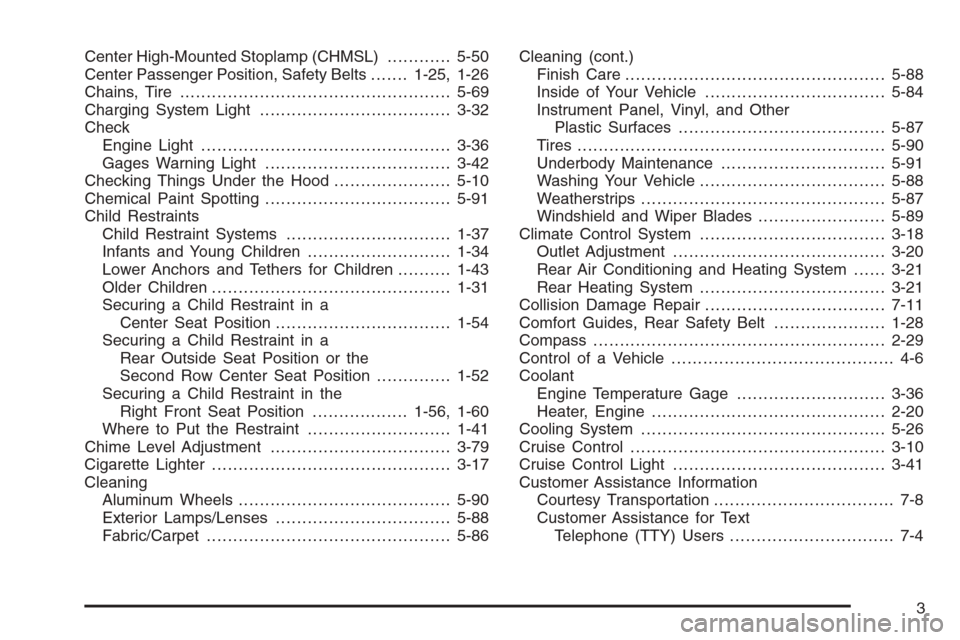
Center High-Mounted Stoplamp (CHMSL)............5-50
Center Passenger Position, Safety Belts.......1-25, 1-26
Chains, Tire...................................................5-69
Charging System Light....................................3-32
Check
Engine Light...............................................3-36
Gages Warning Light...................................3-42
Checking Things Under the Hood......................5-10
Chemical Paint Spotting...................................5-91
Child Restraints
Child Restraint Systems...............................1-37
Infants and Young Children...........................1-34
Lower Anchors and Tethers for Children..........1-43
Older Children.............................................1-31
Securing a Child Restraint in a
Center Seat Position.................................1-54
Securing a Child Restraint in a
Rear Outside Seat Position or the
Second Row Center Seat Position..............1-52
Securing a Child Restraint in the
Right Front Seat Position..................1-56, 1-60
Where to Put the Restraint...........................1-41
Chime Level Adjustment..................................3-79
Cigarette Lighter.............................................3-17
Cleaning
Aluminum Wheels........................................5-90
Exterior Lamps/Lenses.................................5-88
Fabric/Carpet..............................................5-86Cleaning (cont.)
Finish Care.................................................5-88
Inside of Your Vehicle..................................5-84
Instrument Panel, Vinyl, and Other
Plastic Surfaces.......................................5-87
Tires..........................................................5-90
Underbody Maintenance...............................5-91
Washing Your Vehicle...................................5-88
Weatherstrips..............................................5-87
Windshield and Wiper Blades........................5-89
Climate Control System...................................3-18
Outlet Adjustment........................................3-20
Rear Air Conditioning and Heating System......3-21
Rear Heating System...................................3-21
Collision Damage Repair..................................7-11
Comfort Guides, Rear Safety Belt.....................1-28
Compass.......................................................2-29
Control of a Vehicle.......................................... 4-6
Coolant
Engine Temperature Gage............................3-36
Heater, Engine............................................2-20
Cooling System..............................................5-26
Cruise Control................................................3-10
Cruise Control Light........................................3-41
Customer Assistance Information
Courtesy Transportation.................................. 7-8
Customer Assistance for Text
Telephone (TTY) Users............................... 7-4
3
Page 405 of 406
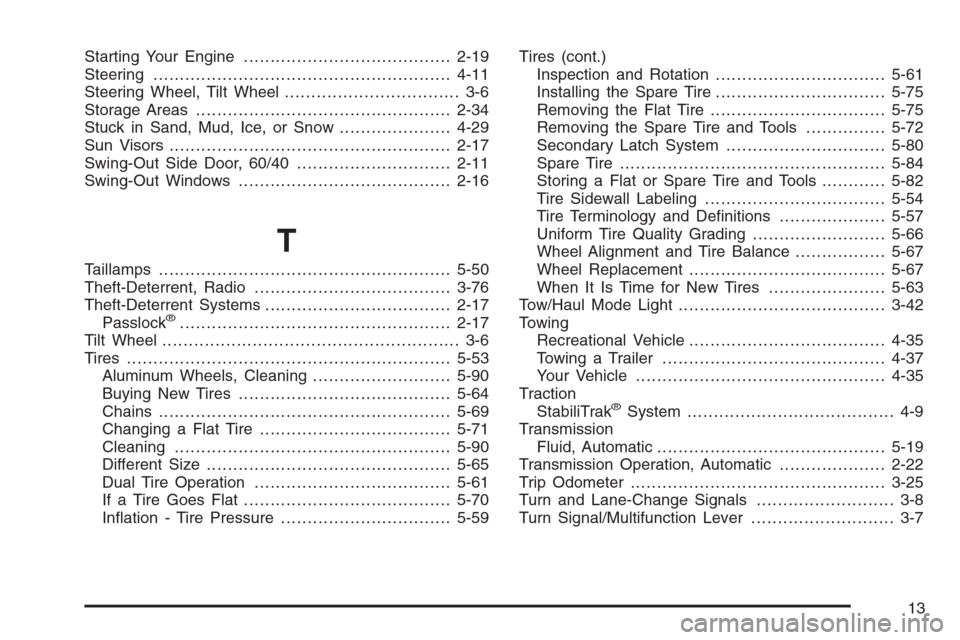
Starting Your Engine.......................................2-19
Steering........................................................4-11
Steering Wheel, Tilt Wheel................................. 3-6
Storage Areas................................................2-34
Stuck in Sand, Mud, Ice, or Snow.....................4-29
Sun Visors.....................................................2-17
Swing-Out Side Door, 60/40.............................2-11
Swing-Out Windows........................................2-16
T
Taillamps.......................................................5-50
Theft-Deterrent, Radio.....................................3-76
Theft-Deterrent Systems...................................2-17
Passlock
®...................................................2-17
Tilt Wheel........................................................ 3-6
Tires.............................................................5-53
Aluminum Wheels, Cleaning..........................5-90
Buying New Tires........................................5-64
Chains.......................................................5-69
Changing a Flat Tire....................................5-71
Cleaning....................................................5-90
Different Size..............................................5-65
Dual Tire Operation.....................................5-61
If a Tire Goes Flat.......................................5-70
Inflation - Tire Pressure................................5-59Tires (cont.)
Inspection and Rotation................................5-61
Installing the Spare Tire................................5-75
Removing the Flat Tire.................................5-75
Removing the Spare Tire and Tools...............5-72
Secondary Latch System..............................5-80
Spare Tire..................................................5-84
Storing a Flat or Spare Tire and Tools............5-82
Tire Sidewall Labeling..................................5-54
Tire Terminology and Definitions....................5-57
Uniform Tire Quality Grading.........................5-66
Wheel Alignment and Tire Balance.................5-67
Wheel Replacement.....................................5-67
When It Is Time for New Tires......................5-63
Tow/Haul Mode Light.......................................3-42
Towing
Recreational Vehicle.....................................4-35
Towing a Trailer..........................................4-37
Your Vehicle...............................................4-35
Traction
StabiliTrak
®System....................................... 4-9
Transmission
Fluid, Automatic...........................................5-19
Transmission Operation, Automatic....................2-22
Trip Odometer................................................3-25
Turn and Lane-Change Signals.......................... 3-8
Turn Signal/Multifunction Lever........................... 3-7
13